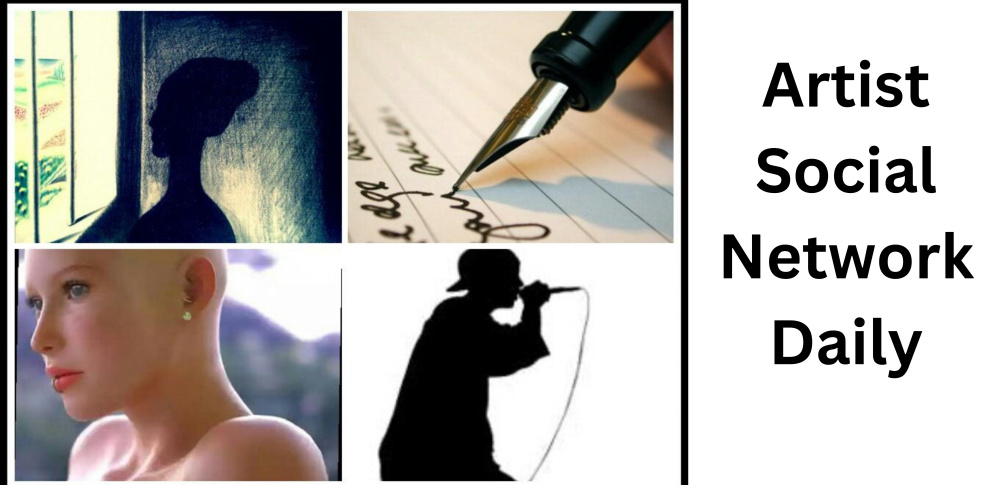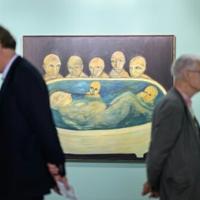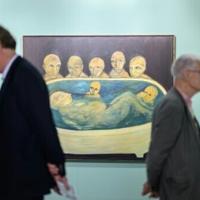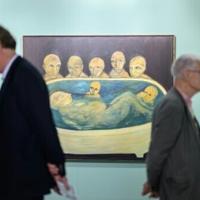Art Market
Tom Seymour
May 14, 2025 4:24PM
Exterior view of Photo London 2024. Courtesy of Photo London.
Photo London returns to Somerset House for its tenth edition at a pivotal moment for the photography market.
Founded in 2015, Photo London emerged as lens-based fine art was gaining recognition as a collectible asset. Previously considered niche, photography was asserting itself within the city’s art ecosystem. Larger, Mayfair-centric commercial galleries were beginning to dedicate significant space to photographic works, while smaller, photography-focused dealers such as Atlas Gallery, Huxley-Parlour, and Flowers were enjoying rising profiles.
Today, as the fair marks a decade of operations, photography is firmly entrenched in the art world mainstream. Blue-chip galleries now routinely display photographic works alongside painting and sculpture at art fairs like Frieze and Art Basel. This shift was exemplified by mega gallery Hauser & Wirth’s decision to represent Cindy Sherman in 2021—a bellwether event for photography’s ascent. Sherman, who began her career in the 1970s, was long overlooked by major art fairs but now shares gallery representation with icons like Louise Bourgeois and Philip Guston. In 2023, fellow mega gallery Gagosian announced its representation of Nan Goldin and brought original prints by Francesca Woodman to Art Basel, alongside personal works by the fashion photographer Richard Avedon.
Nan Goldin, interior view of Gagosians booth at Frieze New York 2023. Photo by Casey Kelbaugh / CKA. Courtesy of CKA and Frieze.
Advertisement
If the market served by Photo London is expanding, it is also evolving—for few mediums will be as disrupted by new technologies as photography. This year, concerns about AI-generated imagery are likely to weave their way into conversations with prospective buyers and enthusiasts.
Before the 2023 edition of the fair, German artist Boris Eldagsen submitted Pseudomnesia: The Electrician (2023), an AI-generated image created with DALL·E 2, to the Sony World Photography Awards’ Creative Category. Industry-recognized judges awarded Eldagsen the prize, unaware that the work was created without a camera. Eldagsen declined the award, arguing that AI-generated images—what he called “promptography”—differ fundamentally from photography. The incident, which made global headlines, underscored how AI tools challenge established definitions of the medium and can thus disrupt market structures. Questions abound as to how AI will challenge the art form—or reshape it altogether. “The photo scene in London a decade ago was founded on a more traditional type of platform,” said Timothy Persons of the Berlin gallery Persons Projects. “That is changing, but gradually and slowly.”
Other collectors are more upbeat. “Photography is a strategy for ideas and image making, and it is incredibly effective,” said Benjamin Tischer of the New York gallery New Discretions, which is bringing work by Jordan Eagles to Photo London this year. “Jordan is using photography as the foundation of the work, but building upon it,” Tischer added. “Is it photography? Yes, and wall sculpture as well.”
than ever before. Over 100 galleries will attend the fair, including dealers from cities as far-flung as Taipei, Istanbul, Buenos Aires, Seoul, Reykjavík, and New Orleans. Significant displays of work by photographers from Tehran and Palestine will also be included.
This year’s edition also marks a leadership change, with Sophie Parker taking the helm as director. At 36, Parker is an insider who has risen through the ranks. She is determined to modernize the event, making it more responsive to the everyday and often ephemeral practices of photography. Her vision is to broaden the fair’s accessibility. “I want anybody coming to this fair to feel comfortable and confident to speak to galleries and have conversations,” she said. “It’s important that the experience isn’t intimidating—that it’s open and inviting to new collectors and seasoned ones alike.”
Photo London often mirrors generational divides within the art world. Classic prints from the medium’s storied masters, created with analogue processes, cater to the desires of established collectors who value historical significance. This is a traditional segment of the market that long predates the fair.
Installation view of Photo London 2024. Courtesy of Photo London.
But, over the last decade, new impetus has come from emerging markets in Asia and the Middle East, as well as from younger collectors whose engagement is driven by social media. “Photography is the visual language of this century due in part to the advancement of the mobile phone,” said Persons. “Because collecting photography is still affordable, it is attracting a younger generation’s attention.”
This new collector class is increasingly interested in NFT photography, augmented reality, and immersive installations that blur the lines between photography, fine art, and digital culture. “Gen-Z collectors in particular are gaining in importance,” said Alexander Golya, sales director at CAMERA WORK in Berlin. “They have grown up with the medium of photography and are primarily looking for contemporary art by artists such as Christian Tagliavini and Eugenio Recuenco, who work across genres.”
Yet, a question remains: is Photo London truly capturing this momentum? At Paris Photo last autumn, digital art gallery Fellowship showcased American artist Trevor Paglen’s ongoing “Evolved Hallucinations” series—a deeply researched exploration of how AI produces representations of physical reality. Paglen’s images, created by a generative adversarial network trained to classify and generate new visuals, stirred significant interest. Despite its growth, Photo London faces an increasingly competitive landscape. Unseen Photo Fair in Amsterdam, once a major player in Europe’s photography market, went bankrupt in 2020 but is slated for a comeback in a new dockside location this September. During the pandemic, Photo London struggled, arguably losing ground to Paris Photo, its larger and more established rival.
Yet, a question remains: is Photo London truly capturing this momentum? At Paris Photo last autumn, digital art gallery Fellowship showcased American artist Trevor Paglen’s ongoing “Evolved Hallucinations” series—a deeply researched exploration of how AI produces representations of physical reality. Paglen’s images, created by a generative adversarial network trained to classify and generate new visuals, stirred significant interest. Despite its growth, Photo London faces an increasingly competitive landscape. Unseen Photo Fair in Amsterdam, once a major player in Europe’s photography market, went bankrupt in 2020 but is slated for a comeback in a new dockside location this September. During the pandemic, Photo London struggled, arguably losing ground to Paris Photo, its larger and more established rival.
As a response, the fair has diversified its offerings with virtual tours and online platforms, ostensibly to reach broader audiences but also as a hedge against digital disruption. “When I first started back in 2018, we only worked with galleries that had physical spaces,” Parker said. “Very quickly, we saw the way people interacted with art was changing—online galleries became much more normal, and we adapted to that.”
Yet a gap exists here that is yet to be bridged. “The older collectors are no longer as active as they once were, and the upcoming generation needs more time to mature,” said Persons. “Thus creating a hesitant market.”
Some gallerists suggest the fair could push boundaries even further. “If I were on the committee of Photo London, I would create an additional section: it looks like photography, but it’s not photography,” said Cyrille Catherin of Galerie ORIANE in Munich. “Pushing the boundaries of photography without going too far.”
As it enters its second decade, Photo London must grapple with how digital and machine-generated art fits into its curation strategies. To reflect photography at its most contemporary, addressing these technological shifts will be crucial.
Whether Photo London can maintain its relevance amid these changes remains to be seen. Its role as both a commercial hub and a cultural platform will depend on its ability to respond to the evolving dynamics of the photography market. As it marks its tenth edition, the fair stands at a crossroads—an emblem of photography’s growth, and a measure of its future resilience as a momentary, lens-based art.
Tom Seymour
This post was originally published on this site be sure to check out more of their content



